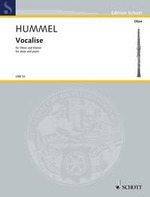Vocalise for Oboe and Piano (1994)

Dedication:
for Martin
Duration: 3 minutes
Misprint: piano, right hand, b. 17: second last quarter A flat instead A
This newly created art form inspired composers such as Fauré, Ravel, Stravinsky, Villa-Lobos and Rachmaninov to produce melodious vocal and instrumental pieces categorised under the French term vocalise which enjoyed great popularity.
In adherence to this tradition, Bertold Hummel composed this piece in celebration of the birthday of one of his sons, revealing the age of the son in question in the number of bars
contained in the work (whereby a ten-bar da capo was subsequently deleted for practical reasons!).
Hummel’s Vocalise is available in four versions: for voice, oboe, clarinet or soprano saxophone and alto saxophone, all with piano accompaniment. The respective score was transposed for the instrument.
Martin Hummel
